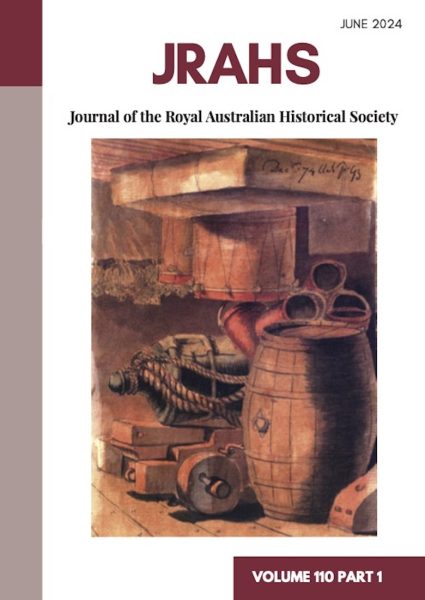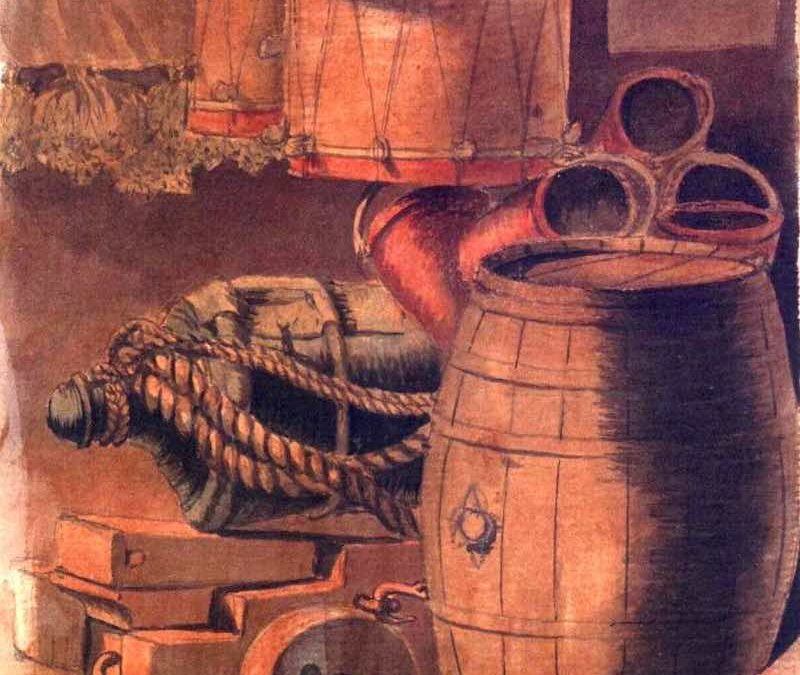Journal of the Royal Australian Historical Society
Vol 110 Pt 1 June 2024
Editorial

Coming to the helm as Editor of the Journal, I am pleased that my first issue is one that responds to feedback from the Royal Australian Historical Society community. I am proud that it reflects that at its core, the Journal is a publication from members, for members, by members, and with members. As such, it has sought to give a spotlight to member submissions (within this issue) and member ideas (such as the new ‘Interpreting an Image’).
In the intricate tapestry of history, there are often overlooked threads that, when unravelled, reveal fascinating narratives of human resilience, struggle, and ingenuity. The submissions of various research endeavours presented here provide a glimpse into these forgotten landscapes, shedding light on aspects of Australian history that have long been overshadowed by more prominent narratives. From the misfortunes of Lieutenant Charles Jeffreys to the use of legal regulations in labour struggles with railway navvies, and from the power of storytelling to the resilience of communities during times of economic hardship, I believe each paper explores and sheds light onto a distinct facet of the Australian experience.
The story of Lieutenant Charles Jeffreys and his ill-fated command of the Kangaroo serves as a poignant reminder of the challenges faced by early colonial administrators. Governor Macquarie’s scathing assessment of Jeffreys as ‘inactive and negligent’ underscores the complexities of leadership in a rapidly evolving colonial context. Jeffreys, if inactive and negligent, was no different to other colonial leaders before or after him (including up to the present). By examining previously overlooked aspects of Jeffreys’ tenure, Ian Dodd provides a more nuanced understanding of his character and competence, ultimately reassessing the validity of Macquarie’s harsh judgment.
In contrast to the struggles of colonial administrators, the paper by Dr Terry Kass highlighting the plight of railway navvies through the lens of legal regulations offers a glimpse into the harsh realities faced by working-class labourers during the era of industrialisation. As the arteries of the modern world, railways facilitated economic growth and connectivity, yet behind the scenes, the toil of railway navvies laid the foundation for this transformative infrastructure. Robert Hughes in his seminal work, The Fatal Shore, posited that the deeply militarised society of the early Sydney colony and the use of military personnel to aid the civil power against industrial action had led to the particularly Australian aversion to strike-breaking. This is something that I have written on elsewhere and agree with completely. I believe that Dr Kass’s wonderful research confirms this. The paper speaks to the resilience and determination of those whose labour often goes unrecognised in the annals of history.
Shifting our focus from physical infrastructure to cultural heritage, the abstracts discussing the influence of Ion Idriess’s Drums of Mer (amongst Idriess’s many famous works, now starting to make a revival within Australia) and the enigmatic Four Gospels offer insights into the power of storytelling and the complexities of colonial encounter. Through these texts, we glimpse two societies engaging beyond the colonial gaze (of Torres Strait Islanders and Indigenous Australian warfare) as well as the enduring impact of narrative on collective memory. With the ‘Coming of the Light’, we see as well the intersections of faith, culture, and identity in the colonial context. Rob Coutts grapples with questions of authenticity and interpretation, seeking to unravel the intricate layers of influence and meaning embedded within these texts.
Finally, Leonie Bell’s paper detailing the forgotten history of Canvas Towns and makeshift settlements during the Great Depression and World War I sheds light on the resilience of communities in the face of economic hardship. These forgotten landscapes, scattered across the sand hills and scrub of Sydney, offer a glimpse into the ingenuity and resourcefulness of those who sought shelter and stability during tumultuous times. The discovery of Canvas Town, hidden from view on maps of the period, serves as a poignant reminder of the importance of uncovering and preserving forgotten histories for future generations.
These are the substantive papers. In addition to them, this issue of the Journal introduces the idea of ‘Interpreting an Image’. The suggestion came directly from RAHS member Dr Bruce Pennay and replicates the excellent work done by other branches of Australian historical societies. As I have noted in my ‘Vision for the Journal’, my aim over the stewardship of this publication is to reduce the professional (and institutional) barriers to Australian history. There is a lot in our backyard (figuratively and literally) to be written about and this need not be in a dense, archaic form of a journal article. This is not to say there is not a time and place for in-depth academic writing. However, if the JRAHS seeks to engage more with its members and local historians, new means and methods must be found. I am excited then that this issue highlights the first tranche of this new development for the Journal.
In conclusion, the papers presented here offer a diverse array of narratives that collectively enrich our understanding of the Australian experience. From the struggles of colonial administrators and working-class labourers to the resilience of communities during times of economic hardship, each abstract reveals a different facet of the Australian story. As researchers continue to delve into these forgotten landscapes, they remind us of the importance of preserving and honouring the diverse voices and experiences that shape our shared history.
Dr Samuel White
Editor, Journal of the Royal Australian Historical Society
Media Enquiries:
Suzanne Holohan, General Manager, Royal Australian Historical Society.
E: history@rahs.org.au, Ph: (02) 9247 8001.
RAHS members can download and read articles published in the Journal by logging into their online members’ account. Click here to log in to your member account.


0 Comments